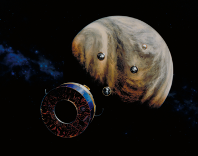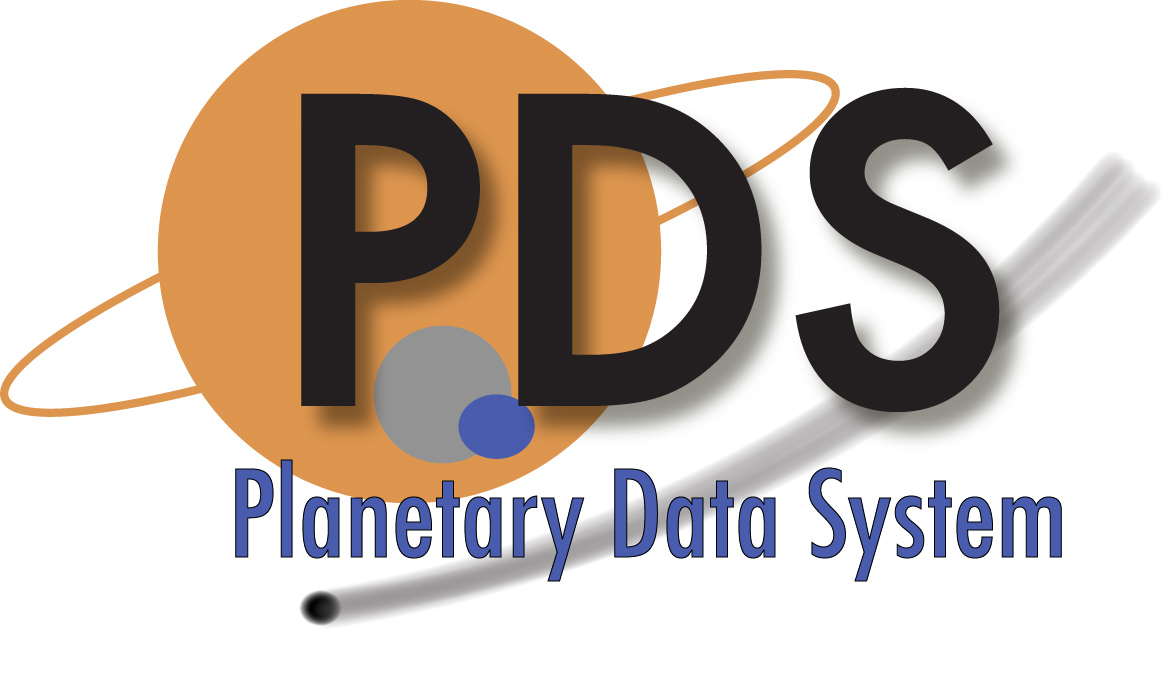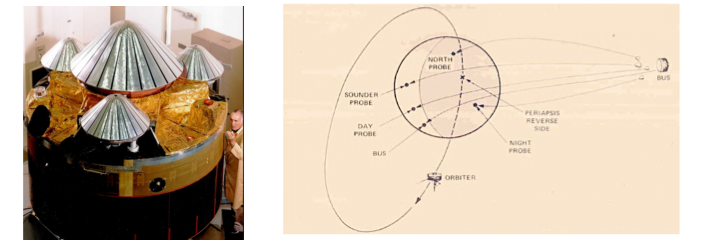
Introduction
The Pioneer Venus orbiter entered orbit on Dec 4, 1978 and the mission ended Oct 8, 1992. It carried 16 instruments to study plasma interaction with the upper atmosphere, make multi-wavelength observations of the clouds and to map the surface with radar. The UV data contained in this dataset were obtained between 1978 and 1992. Retrieval of this data set was begun years ago, thus ATM has chosen to review it as a PDS3 data set and to do the migration later.
This PVOUVS dataset spans the tie from 1978-12-05 to 1992-10-07 and consists of 7476 caibrated fie plus supporting data. Thus it provides a mission-long set of observational data at several far-UV and near-UV wavelengths associated with day and night airglow emissions and with reflected sunlight. All Venus phases are sampled, as are all levels of solar activity during 1978-1992.
Reference
Stewart, A. I., D. E. Anderson, Jr., L. W. Esposito, and C. A. Barth, 1979, "Ultraviolet Spectrometry of Venus: Initial Results from the Pioneer Venus Orbiter', Science, 203, 777-779
Stewart, A. I. F., 1980, "Design and Operation of the Pioneer Venus Orbiter Ultraviolet Spectrometer', I. E. E. E. Trans. on Geosci. Remote Sensing, GE-18, 65-70 transactions on Geoscience and Remote Sensing, GE-18, 65-70, 1980.
Esposito, L. W., J. R. Winick, and A. I. Stewart, 1979, "Sulfur Dioxide in the Venus Atmosphere: Distribution and Implications', Geophys. Res. Lett., 6, 601-604
Stewart, A. I. F., J.-C. Gerard, D. W. Rusch, and S. W. Bougher,1980, "Morphology of the Venus Ultraviolet Night Airglow", J. Geophys. Res., 85, 7861-7870 Knollenberg, R., L. Travis, M
Accessing the Data
PVOUVS Bundle
Aareadme file
Mission description
Spacecraft description
Ultraviolet spectrometer description
Documents
Data
Calibrated data
CAL log
The data contained within this dataset represent a preliminary calibration of the raw data returned by the OUVS instrument using the laboratory calibration curves (see CALIB directory). The sensitivity of the instrument has been shown by Esposito et al 1988 to have decreased with time. Furthermore, the rate of this loss of sensitivity was also shown to be wavelength dependent. Use of data from observations made later than the first roughly 500 days of the mission must take into account this decay in instrument sensitivity.
GEO data
The parameters contained within this data are calculated from the information contained within the associated orbit attitude and telemetry files for each orbit. The pointing vector or the view direction of the OUVS instrument is calculated from the known orientation of the instrument on the spacecraft bus (+306 degrees from the spacecraft +X axis), the orientation of the spin (Z) axis of the spacecraft, the timing of the specific spatial reference pulse, the reported delay following the reference pulse before the start of data acquisition, the integration period of the photodetector (all from the returned telemetry data), and the location of the spacecraft in the Venus-centered geometry (interpolated to the telemetry data time stamps from the orbit attitude data). Venus is assumed to be a sphere with a radius of 6126km centered on the planet center (i.e., a cloud altitude of 75km is assumed). The first intersection of this pointing vector with this sphere defines the observed geometry for Venus. If the pointing vector is not found to intersect the planet, then /NaN/ is returned by the code for all planetocentric angles (i.e., longitude, latitude, emission, incidence, etc.), and the Limb Altitude (LimbAlt) is calculated as the altitude above the reference Venus radius at the closest approach of the boresight ray to the planet. When the boresight ray intersects the sphere defined by the reference radius, LimbAlt is assigned /NaN/.
See GEO log
OA data
The OA data contain a summary record that contains the orbit number of the data product, the calendar date and time at the start and end of the data stream, the date and time of the most recent periapse passage, and the date and time of the file creation. The summary record also includes a designation for the level of data processing, an unknown integer value and the number of records contained within the file. The OA data products contain a number of records at specified UTC dates and times of the spacecraft (𝑥, 𝑦, 𝑧) position and velocity in the VCO frame, the spacecraft-to-Sun vector in the same frame, the nine elements of a 3 × 3 transformation matrix to convert from VCO coordinates to Ecliptic Coordinates, the roll angle and the spin rate of the spacecraft, and two integers the meaning of which we have not been able to decipher. More detailed descriptions can be found in the OA Data Labels. These data products are equivalent to CODMAC Level 1 (NASA Level 0) data products.
See OA log
TM data
The raw data from the PVOUVS instrument are present in orbits 2581 through 2585 and 2614 through 2649. A discussion of the analysis is available in the following paper: Pioneer Venus measurements of H, O, and C production in comet P/Halley near perihelion, A.I.F. Stewart, in Astron. Astrophysics 187, 369-374 (1987). Multiple other comets were observed by PVOUVS, these data are now also included in the archive, andcan be identified by means of their inclusion in the TARGET_LIST of the relevant labels.
See TM log
CAL log
The data contained within this dataset represent a preliminary calibration of the raw data returned by the OUVS instrument using the laboratory calibration curves (see CALIB directory). The sensitivity of the instrument has been shown by Esposito et al 1988 to have decreased with time. Furthermore, the rate of this loss of sensitivity was also shown to be wavelength dependent. Use of data from observations made later than the first roughly 500 days of the mission must take into account this decay in instrument sensitivity.
GEO data
The parameters contained within this data are calculated from the information contained within the associated orbit attitude and telemetry files for each orbit. The pointing vector or the view direction of the OUVS instrument is calculated from the known orientation of the instrument on the spacecraft bus (+306 degrees from the spacecraft +X axis), the orientation of the spin (Z) axis of the spacecraft, the timing of the specific spatial reference pulse, the reported delay following the reference pulse before the start of data acquisition, the integration period of the photodetector (all from the returned telemetry data), and the location of the spacecraft in the Venus-centered geometry (interpolated to the telemetry data time stamps from the orbit attitude data). Venus is assumed to be a sphere with a radius of 6126km centered on the planet center (i.e., a cloud altitude of 75km is assumed). The first intersection of this pointing vector with this sphere defines the observed geometry for Venus. If the pointing vector is not found to intersect the planet, then /NaN/ is returned by the code for all planetocentric angles (i.e., longitude, latitude, emission, incidence, etc.), and the Limb Altitude (LimbAlt) is calculated as the altitude above the reference Venus radius at the closest approach of the boresight ray to the planet. When the boresight ray intersects the sphere defined by the reference radius, LimbAlt is assigned /NaN/.
See GEO log
OA data
The OA data contain a summary record that contains the orbit number of the data product, the calendar date and time at the start and end of the data stream, the date and time of the most recent periapse passage, and the date and time of the file creation. The summary record also includes a designation for the level of data processing, an unknown integer value and the number of records contained within the file. The OA data products contain a number of records at specified UTC dates and times of the spacecraft (𝑥, 𝑦, 𝑧) position and velocity in the VCO frame, the spacecraft-to-Sun vector in the same frame, the nine elements of a 3 × 3 transformation matrix to convert from VCO coordinates to Ecliptic Coordinates, the roll angle and the spin rate of the spacecraft, and two integers the meaning of which we have not been able to decipher. More detailed descriptions can be found in the OA Data Labels. These data products are equivalent to CODMAC Level 1 (NASA Level 0) data products.
See OA log
TM data
The raw data from the PVOUVS instrument are present in orbits 2581 through 2585 and 2614 through 2649. A discussion of the analysis is available in the following paper: Pioneer Venus measurements of H, O, and C production in comet P/Halley near perihelion, A.I.F. Stewart, in Astron. Astrophysics 187, 369-374 (1987). Multiple other comets were observed by PVOUVS, these data are now also included in the archive, and
See TM log
Calibration of f and g channels
Citation
PDS recommendations for citing data sets can be found here.
 PDS: The Planetary Atmospheres Node
PDS: The Planetary Atmospheres Node


